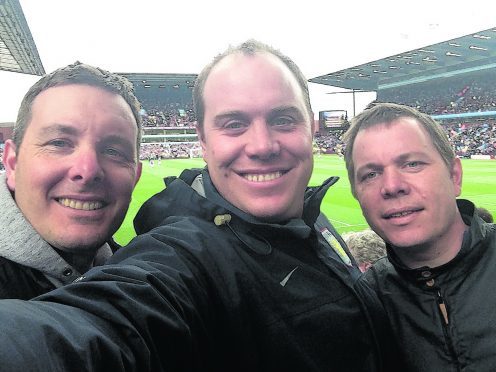Alex Russon resigned from a sensible bank job and talks to Natasha Mckim about his hope for a future in writing after publishing his latest book
Alex Russon, 47, lived in Stonehaven from 1982 to 1986 when he went to Mackie Academy. For him, Stonehaven has always felt like home, despite living there only briefly. He now lives in nearby Auchenblae with his wife and three young children and has written a book, Stoney Baloney, about Stonehaven Golf Course and his memories of the area.
HAVE YOU PUBLISHED A BOOK BEFORE?
Yes, three of them. The first two were about seasons in the life of amateur football teams I played for in Walsall. The third one, Sweet Talk, was an account of what it’s like to set up and run an old-fashioned sweet shop which was the first and only business of my wife and I.
The books are written in a humorous style throughout but I always include a rather more serious short chapter describing my story of alcohol recovery, to try and encourage people suffering with alcohol addiction that all is not lost. If I can quit drinking then, believe me, anybody can.
HOW DID YOU FIRST GET INTO WRITING?
My brother Stuart and I ran an Aston Villa fanzine in the ‘90s called The Villa Bugle. We did it for four years and it was very popular. Off the back of this, I wrote a weekly column for the local Saturday evening sports paper, The Sports Argus, and articles for football magazines 442 and When Saturday Comes.
HOW DID THIS BOOK, STONEY BALONEY, COME ABOUT?
I rejoined Stonehaven Golf Club when relocating to the area last year and played the winter league doubles with an old pal. We had a blast and I wrote a blog – www.stoneygolf.blogspot.com – throughout the season which I decided to develop into a book. People were enjoying the blog accounts of our escapades and it encouraged me to write the book.
WHY STONEHAVEN GOLF COURSE?
I was a member there as a teenager and have very fond memories of the place, it’s very dear to my heart. It gets a rough press from golfing purists given its sloping fairways – it’s located virtually on the cliff edge – and idiosyncratic nature but members adore the place. I wanted to put it on the map positively, to write a tribute to a very special place in my heart.

HOW LONG DID YOU SPEND RESEARCHING?
My memories of the place and knowledge of the course are so deep that it didn’t need much researching, given the bulk of the book is a commentary on actual and fictional events. I spent a good few hours poring over historical committee meeting minutes for the chapter on the club’s history. I met with former players who went on to become very good golfers and are well known in north-east golf, including Bryan Innes and Andrew Locke.
WERE THERE ANY PARTICULARLY SURPRISING STORIES THAT CAME TO LIGHT WHILE WRITING THE BOOK?
The success that Bryan Innes went on to achieve in north-east Scotland golf was a surprise and great pleasure to me. We played loads together back in the ‘80s and to discover just how successful he’d become on the amateur circuit was a great pleasure. Andrew Locke was a junior member with us and is now coach for Paul Lawrie.The big crater on the first fairway was caused by a World War II bomb. I used to think this was an old wives’ tale but not so.
WHEN DID YOU START GOLFING?
I started at the age of 12 and became a good player for my age as a teenager, winning the Junior Championship at 16.My dad introduced me to the game and I was hooked, spending every spare hour up at the club. However, when I went to university, life took a bad turn in that alcohol became the centre-point of my life and I barely played golf again for another 20 years.
WHAT IS IT YOU LIKE ABOUT THE SPORT?
Being out in the open, at one with nature, away from the stresses of daily life. It provides a release. I enjoy the challenge. It’s a sport you will never truly master and every game presents its own different test. I like the solitary nature of it, you versus the course, no one to blame but yourself if your score is poor, unlike team games, but I also enjoy the sociable side of golf, a few hours in the company of friends.
WHY DID YOU DECIDE TO DONATE THE PROCEEDS AND HOW DID YOU DECIDE WHERE TO?
I write because I enjoy it and not for financial gain. Stonehaven is very dear to me and I wanted to nominate charities dear to the town – RNLI and the Rotary are certainly that. £1,300 has been raised in the six weeks since publication. The aim is to raise £5,000. The book is available from Stonehaven Golf Club or Amazon online.
